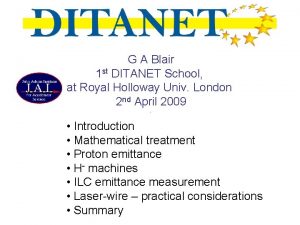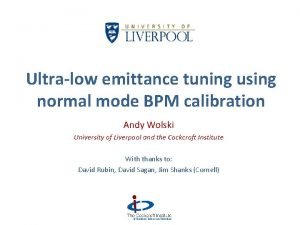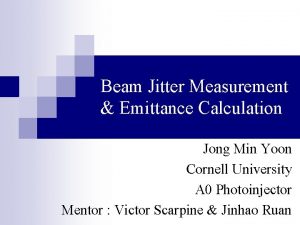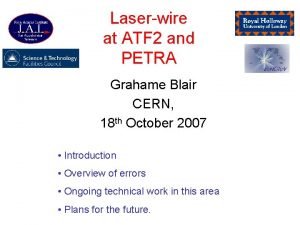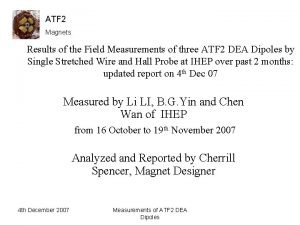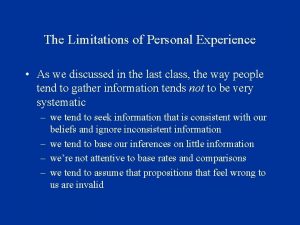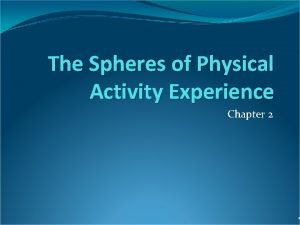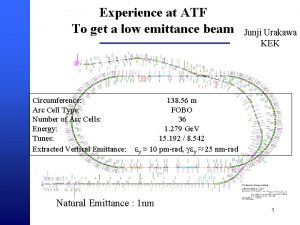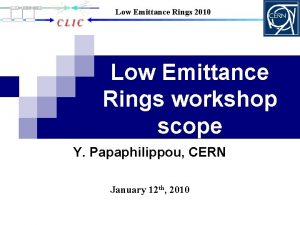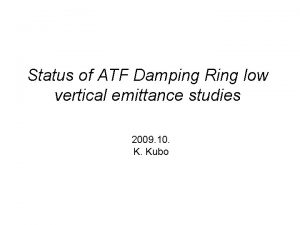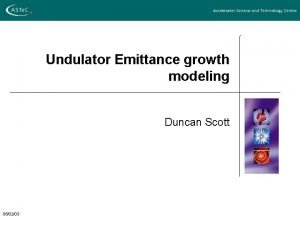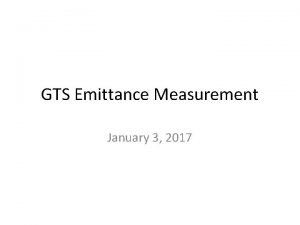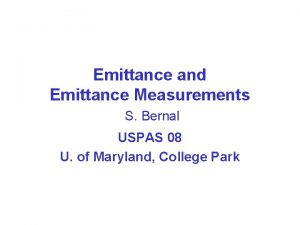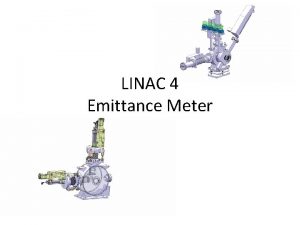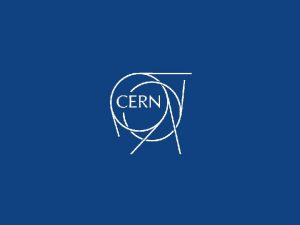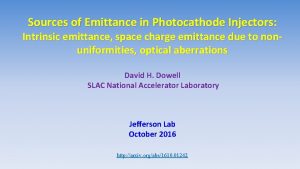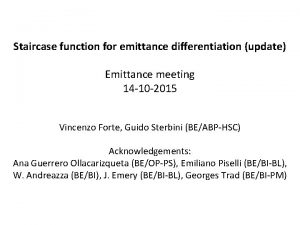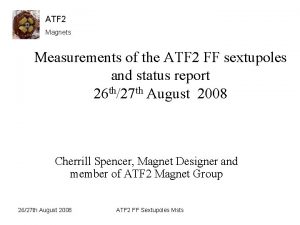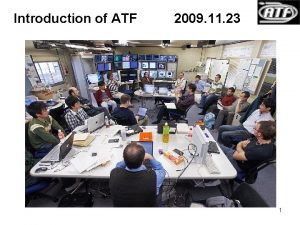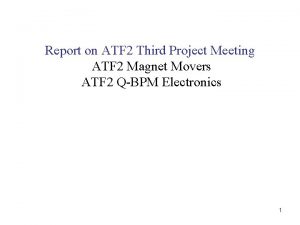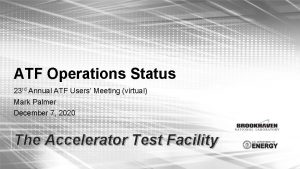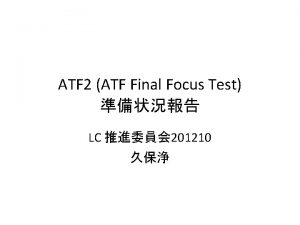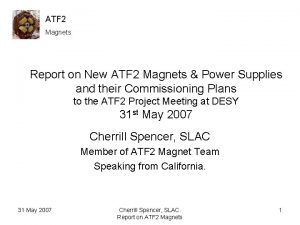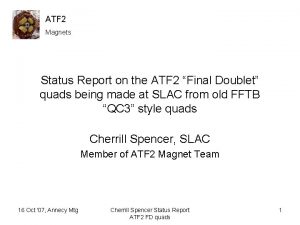Experience at ATF To get a low emittance









![Resolution Improvement Estimated Resolution [ m m] 100 Old first circuit (estimated by beam) Resolution Improvement Estimated Resolution [ m m] 100 Old first circuit (estimated by beam)](https://slidetodoc.com/presentation_image_h2/d5f4095aee50a638299b5f4603f46164/image-10.jpg)
























- Slides: 34

Experience at ATF To get a low emittance beam Circumference: Arc Cell Type: Number of Arc Cells: Energy: Tunes: Extracted Vertical Emittance: Junji Urakawa KEK 138. 56 m FOBO 36 1. 279 Ge. V 15. 192 / 8. 542 y ≈ 10 pm-rad, y ≈ 25 nm-rad Natural Emittance : 1 nm 1

ATF Introduction Emittance status E=1. 28 Ge. V, Ne=2 x 1010 e-/bunch 1 ~ 20 bunches, Rep=3. 125 Hz X emit=2. 5 E-6( at 0 intensity) Y emit=1. 25 E-8( at 0 intensity) 2

DRLBW 44 Optics 3

Arc Cell QF 2 SF BPM SD Combined Function Bend (QD) QF 1 ZV ZH BPM Phase Advance Per Cell: 120. 3° / 48. 5° Phase Advance Between BPMs: 11. 6° / 10. 7° Each quadrupole has an independent trim Each sextupole has an independent skew quadrupole trim 4

Why BBA? • • • Damping rings for JLC/NLC/(ILC) will need to achieve very low vertical emittance – less than 5 pm (not normalized) 2 pm for ILC – roughly factor 2 smaller than so far achieved in electron storage rings (2004) Vertical emittance is an alignment issue – vertical quadrupole misalignments lead to vertical steering which gives vertical dispersion – vertical sextupole misalignments couple horizontal dispersion and betatron motion into the vertical plane Vertical emittance is highly sensitive to misalignments – around 30 µm rms sextupole misalignment will generate 5 pm emittance in otherwise perfect lattice – similar sensitivity in JLC/NLC damping rings Effective correction relies on good performance and understanding of diagnostics BBA can help – “BBA at the KEK ATF”, M. Ross et al, EPAC 2002. 5

Sextupole Alignment Vertical emittance after skew correction based on measured beam offset in sextupoles. Includes orbit distortion ~ 100 um. 6

ATF Damping Ring BPM Electronics: single pass detection for 96 BPMs DC-50 MHz BW, base line clip & charge ADC, min. resolution ~20µm 7

Spectrum of DR BPM Signal peak at ~ 1 GHz 8

BPM electronics improvement Electronics: 40 MHz - 1 GHz BW, base line clip & low noise LF amp min. resolution ~2µm 9
![Resolution Improvement Estimated Resolution m m 100 Old first circuit estimated by beam Resolution Improvement Estimated Resolution [ m m] 100 Old first circuit (estimated by beam)](https://slidetodoc.com/presentation_image_h2/d5f4095aee50a638299b5f4603f46164/image-10.jpg)
Resolution Improvement Estimated Resolution [ m m] 100 Old first circuit (estimated by beam) 10 1 8 10 Improved second circuit (estimated by calibration pulser) 9 10 10 10 Bunch Intensity [electrons/bunch] Min. resolution ~ 2µm 10 11 10

Vertical orbit Improvement 11

Vertical dispersion Improvement 12

X to Y coupling Improvement 13

Laser wire beam size monitor in DR 300 m. W 532 nm Solid-state Laser Fed into optical cavity 14. 7µm laser wire for X scan 5. 7µm for Y scan (whole scan: 15 min for X, 6 min for Y) 14

Beam profile by Laser wire e 2 = meas 2 - lw 2 = e 2 – [ ( p/p)]2 : measured by Q-trim excitation 15

Emittance by Laser wire < 0. 5% y/x emittance ratio Y emittance =4 pm at small intensity 16

BPM Offset Measurement Technique • • • make a closed local bump at target BPM use quadrupole or sextupole (skew quad) trims (ΔQ) make grid scan of bump amplitude and trim setting for each bump value make difference orbit w. r. t. to trim=0 fit difference orbits for kick (k) at quadrupole or sextupole for each bump value fit kick vs trim: k = f (ΔQ) = m ΔQ+b - m is offset from magnetic center - for some trajectory through the magnet, m = 0 • plot fitted offset vs absolute reading of target BPM - horizontal intercept is BPM offset 17

Measurement Challenges • intrinsic BPM resolution (intensity dependent; 20 μm @ 1010 e-/bunch, 40 μm @ 5 109 e-/bunch) ü orbit averaging • intensity dependent position calibration ü monitor intensity stability during acquisition • beam losses in ring cause fluctuating BPM readings ü acquisition: bump/trim range selection (too big … losses; too small … resolution) ü analysis: monitor and cut on relative intensity (stored/injected) • energy drift ü add energy error to horizontal orbit fits • time (single-turn orbit acquisition at 3 Hz machine rate; 20 orbit averaging; 5 bump steps; 5 trim settings; 100 BPMs; x and y) ü automate data acquisition ( 8 minutes/magnet for a single plane) 18

Improved BPM Electronics (2003) 19

Possible Sextupole-Systematic Error Sources IL IR IL IR SF SD differential saturation 20

BPM Performance • • • Measurements of changes in the closed orbit are subject to systematic and random errors – BPM dependence on current – changes in beam energy – BPM noise All relevant effects need to be understood to extract meaningful results from BBA data Model Independent Analysis provides a simple but powerful tool for identifying systematic effects – collect a data set consisting of a large number of orbits, with no deliberate changes in machine settings – analyze the data set to identify correlated changes in BPM readings – correlated changes arise from different sources • orbit changes • energy changes • current changes – uncorrelated changes indicate BPM noise 21

Current Dependence What affects the systematic current dependence? Effect of calibration Red boxes = current correlation, no calibration: Black boxes = correlation with calibration Effect of changing the duty cycle Red boxes = current correlation, reduced duty cycle: Black boxes = correlation, full duty cycle Variation over 24 hours Red boxes = current correlation, March 7: Black boxes = correlation, March 6 22

Good, Bad, Ugly Good Fit Bad Fit 23

Fits to BBA Orbits Green line = MIA modes 1 -4 Points = measured difference orbits 24

Dispersion Correction First attempt RMS reduced from 2. 3 mm to 1. 6 mm black boxes = measured dispersion before correction red boxes = measured dispersion after correction red line = predicted dispersion after correction Second attempt (after using BBA results to steer through sextupoles) RMS increased from 3. 7 mm to 6. 5 mm - as predicted! black boxes = measured dispersion before correction red boxes = measured dispersion after correction red line = predicted dispersion after correction 25

ATF achieved ~4 pm vertical emittance More challenges to reach ~1 pm simulation: • BPM offset error should be < 0. 1 mm. (“BBA”) --> εy ~ 2 pm DR BPM upgrade (SLAC, FNAL, KEK) Single bunch Measured in DR • Magnet re-alignment, < 30 μm. --> εy ~ 1 pm 26

DR-BPM Upgrade (FNAL/SLAC/KEK) Goal: Generation and extraction of low emittance beam (εy < 2 pm) at the nominal ILC bunch charge • A major tool for low emittance corrections: a high resolution BPM system – Optimization of the closed-orbit, beam-based alignment (BBA) studies to investigate BPM offsets and calibration. – Correction of non-linear field effects, i. e. coupling, chromaticity, … – Necessary: a state-or-the-art BPM system, utilizing • a broadband turn-by-turn mode (< 10 µm resolution) • a narrowband mode with high resolution (~ 100 nm range) 27

DR BPM upgrade - Hardware Overview - Narrowband Mode Resolution • Triggered at turn #500, 000 • ~200 ms position data per shot (1280 narrowband mode BPM measurements). • 126 tap box car filter to reject 50 Hz: ~ 800 nm resolution • removing modes with hor. / vert. correlation: ~200 nm resolution 28

DR BPM resolution improvement by digital read-out system (SLAC, FNAL, KEK) beam position read-out vs. beam intensity: scattered plot : existing analog circuit. line plot : digital read-out introduced for test. εy ~ 1 pmへの挑戦 Digital read-out Analogue read-out Stored Beam – 10 minute time scale; ATF lifetime ~ few minutes

The ATF Damping Ring 20 / 96 BPMs were upgraded. Planning to upgrade all (96) BPMs. 30 30

Fast Ion Instability -observed at ATF in 2004 - Bunch ILCシンポジウム, 物理学会 2008春 31

Study on the Fast Ion Instability (KEK, DESY, SLAC, KNU) 2007/Dec~ Under tuning… ILCシンポジウム, 物理学会 2008春 32

Gas Injection system in ATF-DR • • • Continuous gas leak into the beam chamber. We can control the leak rate of N 2 gas. Pressure range: 10 -7 Pa ~10 -3 Pa.

Multi-bunch Turn-by-turn monitor The beam blowup at tail bunches was measured by the laser wire in ATF, which is assumed coming from FII effect. In order to observe the individual beam oscillation in the multi-bunch beam, multi-bunch turn-by-turn monitor has been developed. This monitor consists of front end circuits(amplifier and filter) and DPO 7254 scope. The scope can store the waveform up to 2 ms with 100 ps time resolution. When one bunch from many bunches is kicked, we hope other bunches have almost no oscillation. 1 st 2 nd The preliminary results shows the different oscillation amplitude of the tune-X and the tune-Y for the 1 st and 2 nd bunches at just after injection. Tune-X Tune-Y 34
 Get on get in get off
Get on get in get off Emittance
Emittance Bpm tuning
Bpm tuning Emittance
Emittance Get out get out get out of my head one direction
Get out get out get out of my head one direction Katobolizm
Katobolizm Atf application form
Atf application form Atf hand signals
Atf hand signals Atf
Atf Atf indianapolis
Atf indianapolis Atf
Atf Deltb
Deltb Indirect experience
Indirect experience Imprint definition psychology
Imprint definition psychology Early experience vs later experience
Early experience vs later experience Mid low high
Mid low high Reflective style of communication
Reflective style of communication Low accuracy low precision
Low accuracy low precision Low voltage = low hazard
Low voltage = low hazard Pseudocode for repetition
Pseudocode for repetition Get up get moving quiz
Get up get moving quiz Get focused get results
Get focused get results Get up get moving quiz
Get up get moving quiz Get up get moving quiz
Get up get moving quiz Get up get moving
Get up get moving Alphasonics subliminal
Alphasonics subliminal Inférence définition
Inférence définition Model of buyer behavior
Model of buyer behavior World civilizations the global experience 7th edition
World civilizations the global experience 7th edition Non symbolic consciousness
Non symbolic consciousness To retell the past events
To retell the past events Critical experience prototype
Critical experience prototype Sphere of physical activity
Sphere of physical activity Ah experience
Ah experience Best life experience granada
Best life experience granada

